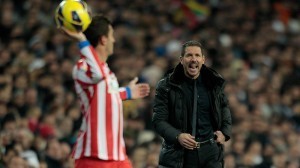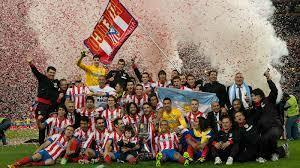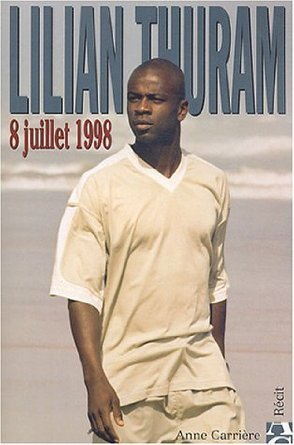Laurent Dubois's Blog, page 91
November 6, 2013
Soccer Street Art in Brazil
Je veux laisser cette vidéo pour commencer la discussion d’art en Brasil. Il existe nombreux artistes qui se concerne avec l’art de football. Quand David Goldblatt nous a rendu visite, il a discute le graffiti en Brazil un petit peu, mais cette vidéo-clip donne un explantation très bonne.
http://www.youtube.com/embed/gdHOAn-D7AE#sthash.7p28UW82.dpuf
El Chocho’s Revolution
The last time Aletico Madrid won La Liga Diego Simeone took the field to captain his side to glory, now on the other side of the locker room, Simeone has led to charge to a rejuvenated Atletico MAdrid side. Atletico has always been known for its long list of talented attackers, Forlan, Falcao Aguero, but they have also been known for having a flimsy defense. Now, the defense that has been criticized a lot over the years has been made a brick wall by Simeone. The change in the attitude of Madrid’s players have been sparked by Simeone’s passion. For the past decade, Atletico has been the second best team in Madrid, now Atletico is a force to be reckoned with throughout Europe.
Diego Simeone is only 43, yet already the tough Argentinian is demonstrating a trait that is only seen in the best of managers, the likes of Guardiola, Ferguson and Mourinho.
Since joining Atletico Madrid as coach in December 2011, Simeone has transformed a suffering, mid-table club into one with a killer instinct. When ‘El Cholo’ was appointed, Atleti were in dire straits: without a domestic trophy since 1996, going through 4 managers in 10 years and each player accepting defeat. Look at Atletico now, the mindset has completely changed. In less than two years, the Argentinian has reversed the defeatist streak, winning the Europa League, UEFA Super Cup and Copa del Rey in the process. This season, Atleti have won 11 of 12 league games and top their Champions League group with a 100% win record. Simeone has turned them into the epitome of winners.
http://www.youtube.com/watch?v=NOsV5zD84w8
The players are behind him a 100%. His inspirational, never die attitude has been embraced by the team. “We are not a team of individuals,” midfielder Arda Turan said. “We are a collective group of hard working players who always want the best for the team. We battle for every ball during every minute of each match and you can see even in training matches that nobody wants to lose. We have a great team spirit, like a family.” “Every match is a final for us,” enthuses Turan. “We take every game as it comes and approach it with the mentality of a final and see what happens. This doesn’t mean that we don’t have big ambitions, I can assure you we do.” Arda Turan is an example of a player who has become a revelation of who he was, since arriving under Simeone. Another example is Diego Costa, who with the departure of Falcao has been forced to take the reigns as goalscorer and he has truly delivered. Diego is currently third in the Golden Boot race scoring a total of 17 goals this year, he is the most prolific striker in Europe’s top flight, after the likes of Messi and Ronaldo.
http://www.youtube.com/watch?v=zCXIIfpjTK4
Simeone has brought glory to the Atleti faithful, but will a La Liga title come anytime soon? Does he have a chance in putting his name amongst the manager greats? In the current form Atletico is in, the sky is there limit.
Carla Overbeck and the 99ers
Next week in our Soccer Politics class we will have the honor of having Carla Overbeck, the captain of the 1999 U.S. Women’s World Cup team, visit our class. She’ll be offering us her perspectives on the broader history of women’s soccer in the U.S. In preparation, we’ll be exploring a range of materials that explore this history.
This recent ESPN documentary called the 99ers provides a riveting recounting of the events of 1999.
This blog includes a range of materials on women’s soccer.
Finally, there have been a series of posts on women’s soccer on this blog by various authors.
These include
The video below is an extract from a lecture delivered by Jennifer Doyle about the history of women’s soccer on the international stage, called “Marta’s Pink Star.”
As a supplement to this I highly recommend the archive of Jennifer Doyle’s commentary on women’s soccer from her (now defunct) blog From A Left Wing.
We welcome your thoughts and reactions to this material as well as other suggestions.
November 5, 2013
Goal-Line Technology: A Source of Cost and Controversy
On October 10, FIFA announced that GoalControl GmbH would be the official provider of goal-line technology (GLT) for the 2014 World Cup in Brazil. GLT was first successfully used in the FIFA Confederations Cup Brazil 2013, and although there were no goal-line incidents which required the technology to determine whether or not a goal had been scored, the system met all necessary FIFA requirements and correctly indicated every one of the 68 goals correctly.
How It Works
GoalControl’s system utilizes 14 high-speed cameras – 7 on each goal – that take full-frame, full-color images at a rate of 500 photos/minute. If the ball crosses the goal line, a vibrational and visual signal is sent to each match official’s watch with 1 second. While this is all very impressive, GoalControl only guarantees 3 cm of accuracy. For extremely close-call goals, this may not be enough.
Cost and Financial Considerations
GoalControl is estimated to cost $260,000 per stadium and an addition $3,900 per game. This isn’t pocket change, and for teams under financial pressure, GLT might not be an option. The Football League has confirmed using GLT in later rounds of this season’s League Cup, and this decision is primarily money-driven. According to Watford manager, Gianfraco Zola – a recent victim of being denied what appeared to be a legitimate goal against Brighton & Hove Albion, so much money rides on results. A promotion to the Premier League is worth more than £100m to clubs. On the other hand, the MLS will not adopt goal-line technology by 2014 on account of its high cost. Nelson Rodriguez, VP of Competition and Operations, shared that the MLS has met with multiple GLT manufactures, but is planning to wait and see how it works out for other leagues. This is a smart decision for the MLS: holding off on immediate adoption will give the goal-line tech market time to mature, become more competitive and ultimately assure MLS a better deal on a better product.
Do We Really Need GLT?
Goal-line technology has sparked a highly controversial debate. Personally, I believe GLT is a necessary addition to the game. While it is costly, goals in soccer occur so infrequently – unlike other sports where scoring can be constant – that it is absolutely necessary to get these calls right. If a team scores, it is inexcusable not to award the goal on account of human error. The naysayers out there have a few main counterarguments, and I would like to look at each one individually:
1. It will ruin the flow of the game
Soccer is unique in that it is the only sport with nearly uninterrupted play. Other sports allow several timeouts or are composed of a series of discrete points, with natural breaks in between. Soccer’s beauty lies in its natural fluidity and unpredictability, and I agree: goal-line technology should not ruin this aspect of the game. However, I do not believe that GLT will change this. Many are concerned that, like in American football, referees will spend several minutes with their heads underneath a monitor reviewing the play, causing an unnecessary delay and players’ muscle to go cold. As GLT stands now, this will not happen. Goals already cause a pause in action. More importantly, however, GoalControl will subtly alert referees if a goal has occurred. There will be no flags thrown, no unnecessary drama while the referee reviews and the audience watches along on the big screen. At the end of the day, technology will be the deciding factor, not human judgment. I do think the 3 cm margin of error is still too high and will ultimately need to be made smaller, but it is far better than a referee standing 10 yards away.
2. You give a league GLT…
…they’ll want offsides technology. And if you give them offsides technology, they’ll next want penalty area review. To this, I say: let’s cross that bridge when we get there. For now, only goal-line technology exists, and it would be a beneficial additional to the game. Most officiating decisions in soccer are highly subjective; however, goals are binary. The ball either crossed the line or it didn’t, and this can absolutely be decided by a computer.
3. Let’s just get better referees
I have read many a comment on goal-line technology news demanding the need for better referees. I’ll be brutally honest here: this argument is the worst. Referees in top-level national leagues all must rise through the ranks to become Grade 1 officials in a highly selective process. Referees all start at Grade 8 and must pass written exams, fitness tests, and game assessments in order to move to the next level. Those that make it to Grade 1 are the best referees in the entire world. Bad referees do not exist in the EPL, La Liga, MLS, etc. Yes, referees make incorrect calls all the time, but I do not believe “getting better refs” will solve the problem. Even with impeccable positioning, a ref is bound to miss some calls – especially, if it’s in a crowded penalty box and the ball barely crosses the line. Let us leave these incredibly difficult calls to a less fallible source: technology.
What do you think? Does the World Cup need goal-line technology, and more importantly, is it worth the cost?
November 4, 2013
The Beautiful Game Leads to a Beheading
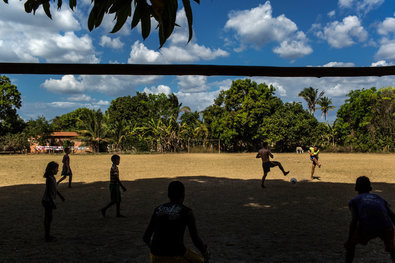
The field in Centro do Meio, Brazil, where two young men were killed after an altercation at a pick up soccer game last June.
Late last week, Jeré Longman and Taylor Barnes of The New York Times relate one of the most chilling stories I have ever read in briliant, gory detail. This is a story of violence, poverty, anger and of course, soccer.
In Centro do Meio, a remote, impoverished town in northwestern Brasil, last June, two young men were killed violently as the result of a pick up game gone horribly wrong. Otávio Jordão da Silva Cantanhede, a 19 year-old who dreamed of being an accountant, rode his bike one Sunday to Centro do Meio to play soccer. In his shorts and his backpack, he carried a knife. During the game, Cantanhede hurt either his knee or ankle, it is not known which. Unable to run, he became the referee. It was in his duty as a referee that he gave two yellow cards to Josemir Santos Abreu, ejecting him. Abreu, 30, and Cantanhede were friendly, having played together before, often on the same side. As many referees and ejected players do, the two began to argue. Cantanhede brandished his knife. Abreu died before arriving at the hospital, the victim of two stab wounds from Cantanhede’s knife.
Here, the story takes an even more gruesome turn. Per Longman and Barnes:
In retaliation, the police said, Cantanhede was set upon by at least four of Abreu’s friends, whose bleakest impulses were fueled by alcohol, drugs and a crowd that stoked the violence the way wind stokes a fire. Cantanhede was tied up, smashed in the face with a bottle of cheap sugarcane liquor, pummeled with a wooden stake, run over by a motorcycle and stabbed in the throat, the police said. The moment of death remained uncertain. What came before did not stop another of the accused from a gruesome completion.
Graphic images taken by hospital workers showed that Cantanhede’s lower legs were cut off and left beside him like prostheses. His right arm and left wrist remained attached by strips of skin. He was decapitated and his head was placed on a wooden fence post across the road from the field.
Valter Costa dos Santos does not blame the incident on soccer. Rather, he believes the killings to represent cultural deficiencies: social issues, substance abuse, poor education, the “despair of poverty.” In my opinion, it is likely that these societal ills, combined with the immense passion Brazilians have for the game, came together in a heinous mixture. This is not an entirely isolated incident. As the article notes, “the Brazilian Center for Latin American Studies, an academic research center in Rio, depicted Brazil as the world’s seventh-most violent country.”
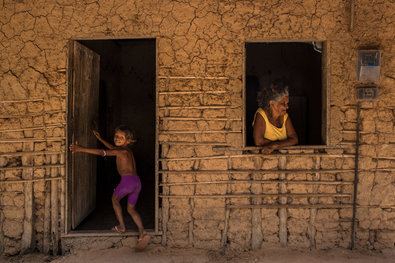
Residents of Centro do Meiro, where the most basic homes are constructed of mud, with roofs of tile or thatched palm fronds.
As the 2014 World Cup, stories like this, in addition to the riots that have accompanied big matches, are the ones that the rest of the world will see. The global audience will be surprised and aghast at such a fundamental breakdown of society’s law and order occurred in one the world’s most rapidly developing nation’s, on whose flag is a creed that translates to “order and progress.” The article states that these killings present “a grisly contradiction to joga bonito,” Brazil’s soccer philosophy that emphasizes beautiful play. Preventing similar tragedies in the future will not be done by prohibiting pick up soccer games. It will be done by improving socioeconomic circumstances of Brazil’s remote poor and maybe, by changing the culture surrounding the game. It’s hard to deny that these incidents are byproducts of a soccer-mad culture. But it is a shame. After all, it’s just a game.
November 3, 2013
English Football Must Install Better Standards for the Issue of Concussions
In case you missed it this morning, there was a very frightening moment during the Everton-Tottenham match. While attempting to get on the end of a long ball, Romelu Lukaku and Hugo Lloris had a terrible collision, where Lukaku’s knee ran directly into Hugo Lloris’s face, ending in both players being injured. However, Lloris’s was obviously the one with the more severe injury, as he laid face down on the grass for several minutes. The medical staff was called onto the pitch and stayed with him to check on his condition and help him regain composure. As one would expect following this frightening injury, Tottenham’s second-string keeper, Brad Friedel, started to warm-up to enter the game for his teammate. However, as Lloris was being ushered off of the field he started to fight back suggesting that he wished to stay in the game. While his dedication to his team was admirable, there was no way he should remain on the field following that sort of injury, especially with such a high severity risk of second-impact syndrome, which can significantly worsen any concussion. [1] But to the surprise of many, the commentators included, he remained on the field, and finished the game.
In the post game interview Tottenham manager, Andre Villas-Boas, was asked about this decision. He responded that he felt it was the right decision despite the fact that medical officials suggested a substitution, and that Lloris had mentioned that he could not remember what happened. [2] This information provided a clear indication that he should have been removed from the game to ensure future safety. However, this negligence is nothing new for the premier league, as Romelu Lukaku himself had a similar concussion scenario earlier this year. In a game against West Ham, Lukaku was knocked unconscious while scoring the game-winning goal and stated, “I didn’t even know that I scored. …I didn’t remember what happened for a couple of seconds.” [3] Furthermore, he even played 3 days later in a cup match, showing a complete disregard for any sort of concussion monitoring, which is a serious issue.
In order to assess the English leagues’ true knowledge about concussions, a questionnaire was sent out at the beginning of the 2009/2010 season. [4] The results were quite surprising where only about three quarters of the teams in England that responded were aware of the Consensus in Sport guidelines pertaining to concussions. Furthermore, only a little over half of the teams used cognitive assessments following a concussion, and only a very small amount followed the review of symptoms and proper rest periods, thus demonstrating a significant mistreatment of the condition. If the English leagues truly want to ensure the safety of their players, they should take after the MLS concussion policies. [5] The MLS policy is a three-step system, where the player must pass cognitive tests, be symptom-free and have clearance from both the team doctor, and team appointed neuropsychologist, a new requirement for every team. If the English leagues truly want to ensure the greatest quality of football as well as the health of their players, they must take the steps necessary to better address this issue of concussions.
References:
[1] http://www.ncbi.nlm.nih.gov/pmc/articles/PMC2672291/
November 2, 2013
Rendezvous with the makers of Pelada
Just yesterday we had an interesting rendezvous with the makers of Pelada. You can watch the film here. While watching the documentary itself was great, meeting Luke Boughen, Gwendolyn Oxenham and Ryan White, in person was even more exciting. Of course, we missed Rebekah Fergusson, the fourth member of the team. Indeed one cannot help admiring how these spunky guys went globe-trotting across 25 countries without even knowing the languages or who or what they were going to bump into at each of these places. In fact, Ryan admitted that today he wouldn’t advise anybody to undertake such projects. But I personally, think that that element of,what may be called “craziness”, is what makes this film all the more different from most other soccer documentaries. There is a certain liveliness and remarkable spontaneity that runs throughout the film and it is evident in both the characters and players in each country and even the filmmakers themselves. One can sense a certain naiveness and that tension is what makes it all the more appealing. The website worldsoccertalk.com lists this film as one of the top 20 greatest soccer films of all time. It even won an award for outstanding achievement in Documentary Filmmaking at the Newport Beach Film Festival in 2010. Here is the interview they gave at the festival.
Both Gwendolyn and Ryan recounted a lot of their experiences in each country. I particularly found the experience they had in Iran quite scary in certain ways, where they almost got into legal trouble with the government for filming. It was also the place where Luke and Gwendolyn got engaged.Throughout the shooting in Iran, the filmmakers were under constant surveillance and Gwendolyn had to keep her head covered in the headscarf. Before leaving the country they also had to show all their footage to the authorities and they were not even sure whether they would be allowed to exit the country. We were even told how they ran out of money each time and had to get back and raise funds. The original budget that they had aimed for was $600,000. But obviously, nobody was going to give them that in one go!! Slowly and perseveringly, they got the funds over a period of 3 years and the result was Pelada. What comes out to you as a listener is their passion to show the world that here was a great story they had about ‘pick-up’ soccer and no matter what came in their way they wouldn’t stop till they had actually shown it. I would definitely recommend this documentary to all those who are interested in the game and even for those who just want to have some entertainment. Gwendolyn has even published a book titled Finding the Game:Three Years,Twenty-Five Countries and the Search for Pickup Soccer which tells you about their adventures “on the road and on the field,” throughout the making of this film.
Lilian Thuram’s Autobiography
Published in 2004 in France — and not yet translated into English — Lilian Thuram’s autobiography 9 Juillet 1998 is a fascinating portrait of contemporary France and of the world of football. In it, he describes his childhood in Guadeloupe and his family migration to the suburbs of Paris, where he grew up in a project outside Fontainebleau. His descriptions of life in the banlieue are particularly striking because of the very positive representation he offers of these spaces that are often seen in a very negative light. He celebrates the diversity and the community he found there. His stories of his early footballing career, notably his mentorship by Arsene Wenger among others, will interest football fans. And his lucid vision — at once celebratory and cautious — of the impact of the 1998 World Cup on France is one of the most interesting parts of the book. In the comments below, students from Duke’s Fall 2013 “Soccer Politics” offer some translations and analysis of particularly interesting passages from this book.
October 30, 2013
The Female Pele and the Growing Pains of Women’s Soccer
“The Best Player on Earth is Looking for a Job”, a New York Times headline declared in 2011. The player they referenced was not Messi–he has a nice job, thank you very much, scoring tricksy goals and baffling defenders as a star forward for Barcelona. No, the player they were talking about was Marta Viera de la Silva, Brazilian wunderkind and so famous she goes only by Marta. Five time FIFA player of the year, Marta is almost indisputably the best player in the world today. And yet, at the time of the article, she was technically unemployed.
Ignore for a moment the fact that she returned to Sweden after this article to play for around a 400,000 dollar salary and consider the comparisons to the men’s game: if you are one of the most elite players in the world, income is certainly not an issue. Nor, for the most part (and barring injury) is finding stable employment…because soccer is the world’s game, and all will pay to see it. But apparently, they won’t always pay for women to play it.
Marta grew up playing with the boys in Dois Raichos, Brazil, showing off her equal skills until a scout found her and introduced her to the game of professional women’s soccer–miraculously, he found a team for her in Brazil, seven years after a countrywide ban on women’s soccer. It’s telling when the world’s best player grew up in a country that didn’t even acknowledge her sport. I can guarantee you no male player faced that same kind of discrimination.
And so Marta flourished. Now, an accomplished star, she is known as the female Pele (by Pele himself, no less) and it has been said by many that she could, theoretically, play the men’s game. She’s that good. But her career has been a hodgepodge of bouncing around leagues as they folded from beneath her, unable to stay afloat due to lack of cash and support.
And why should this be? The women’s game may not be as physical as the men’s, but one can hardly say they play with less skill. Women also flop less and for less time, making for a faster paced game with more action. And soccer is the world’s most popular sport. Women’s soccer in particular has exploded across the globe, with 29 million women and girls playing soccer in 2013 according to FIFA. What are the reasons for the women’s struggles in this sport?
In truth, much of the explosion of the game has been in the US and Europe, western countries with more liberal attitudes towards women and sports. Marta mentioned how in Brazil, soccer is still seen as a masculine sport–something that is not the case in the United States. The middle east also struggles with women’s sports. The West Asian Football Federation has been working on an initiative in 2013 to increase the profile of women’s sports in the region, including U-16 and U-19 competitions in the area.
Something, however, we must remember in terms of soccer and women is that soccer itself took decades to reach the level of superstardom it achieved in the mid 20th century and onward. Women’s sports have only had the chance to be mainstream for a fraction of that time. We must also remember that the status of women’s rights in a country directly influences their participation in sports, and there are a lot of places in the world where the term women’s sports is still an oxymoron, for the most part.
It is apparent here that that problem lies in the gender attitudes around the world, and not the sport itself. FIFA president Sepp Blatter caused an uproar in 2004 when he said that women could increase the popularity of their game by wearing “tighter shorts”. Sorry, Sepp, but female soccer players don’t want to be ogled while they play. They want to be admired for their speed, skill, and sportsmanship. While women’s sports always seem to struggle to find a foothold in terms of popularity, women’s soccer has the unique position of being a part of a sport that is popular worldwide instead of concentrated within one nation. And with the unique stardom that players and teams (like Marta) are experiencing, they are in a good position to move forward. Soccer has been used to effect social change before, and it has resisted the effects of some of the most heavy handed leaders in the world. With the explosion of players in the world in the past few decades, the next feat is to get women like Marta to keep fighting for their sport in their country and support the development of women’s soccer from the ground up.
Should this go well, youth leagues can be developed, women can grow up playing the sport, and this will help the women’s league system stabilize. As the skill and thrill of women’s soccer increases, the popularity of the sport will too–one can see this in the drama surrounding the final games in the Women’s World Cup.
Marta wasn’t unemployed when she wasn’t playing. She was a symbol of how talent is being wasted by not giving women the chance to shine on the international stage on a widespread basis. The growing pains of women’s soccer are also the growing pains of women’s rights.
October 29, 2013
The World Cup: An Opiate for the Brazilian People?
Sometime yesterday Brazil’s Sports Minister Aldo Rebelo was asked about the possible continuation of the protests that have been wide-spread throughout Brazil, especially since last summers Confederations Cup. He stated,
“I don’t believe we will see demonstrations during the World Cup, I think the World Cup will be protected by the will of the people to be supportive of a great event. The mood will be for partying, not for protesting, when the national teams and the tourists start arriving in Brazil.”
While this may be a probable statement, we should ask ourselves what this would say about the Brazilian people and the effect of soccer to distract people from their problems in general. Is a sporting event, even the biggest one known to the planet, worth abandoning a cause as important as fighting against government corruption and almost zero transparency in use of taxpayer dollars? Even if the protests stop for only a month while the World Cup is actually taking place, I feel as if it would greatly weaken their efforts at reform. Such an important issue cannot simply be dropped for a time and picked back up whenever it is convenient. As Eduardo Galeano acknowledges, some people have had the opinion that soccer “castrates the masses and derails their revolutionary ardor”, which would be precisely the case with the World Cup in Brazil, especially when the very thing the masses are so upset about is the billions of dollars that have been spent on the stadiums Rebelo hopes they will soon pay to enter!
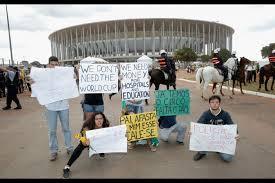
Photo from globalpost.com
We all know that Brazilians love their soccer, and that it can truly serve as an expression of national pride here more than almost anywhere else. However, when the nation isn’t carrying out its duties as ruling body, it is the responsibility of the people to act and demand a change even if this action requires standing outside stadiums chanting and shouting, instead of joyously doing so within.
Laurent Dubois's Blog
- Laurent Dubois's profile
- 44 followers


